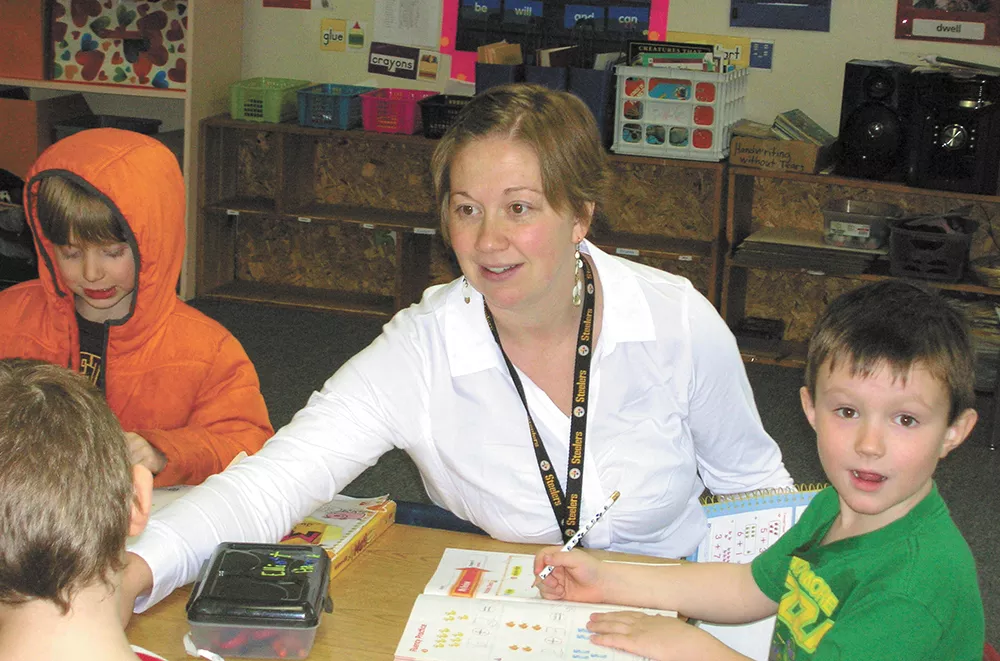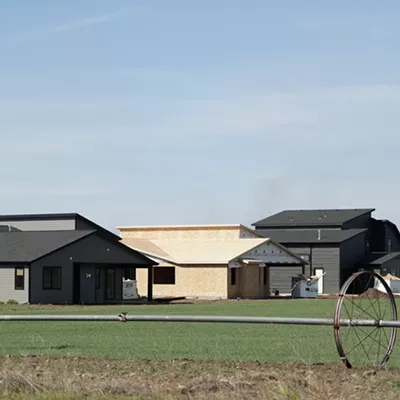At Valley View Elementary School in Bonners Ferry, Idaho, students get this Friday off. Same with next Friday. And the Friday after that. For students at every school in the Boundary County School District, there are three-day weekends as far as the eye can see.
Instead of five, students attend four days a week. The school year is only 141 days. Instead, to meet the state-required number of class time hours, school days are longer. The crew of 22 5-and-6-year-olds rolls into Lauren Bartoe's Valley View kindergarten class at 8 am, and they don't leave for the bus until nearly 4 pm.
In one sense, Bartoe loves it. It means a day to catch up on all of her errands — "to run to the bank and the grocery store and make doctor's appointments and get a haircut."
But as a teacher, she doesn't believe four-day weeks are good for the kids. Eight hours is a long time for kindergartners. That's especially true at the beginning of the year.
"They have more breakdowns," Bartoe says. "'Somebody cut me in line' — they burst out crying. You have more behavioral problems." By the end of the day, she's exhausted too, and her patience is frayed.
Yet in the small rural communities that speckle Idaho, the four-day school week has only increased in popularity. In the fall of 2008, just 14 Idaho school districts and two charter schools were using the four-day schedule. Today, that's grown to 42 school districts and 11 charter schools. Many in those four-day districts say they don't ever want to go back.
For the past three months, Paul Hill, founder of the Center on Reinventing Public Education, has been calling administrators in small towns throughout Idaho, asking about four-day school weeks. "It's way too soon to know whether it's going to have a good impact on kids," he says.
Idaho has been debating precisely that question. In a state superintendent debate last fall, Sherri Ybarra — the ultimate victor — repeatedly brought up the four-day week as an example of where the state had failed to provide even "adequate" funding to its schools. Her opponent, Jana Jones, agreed, arguing that the schedules came about only because of financial necessity.
In 2006, Idaho Gov. Jim Risch's budget radically changed the way the state approached school funding, hitting property-poor districts particularly hard.
"Yes, that destabilized education," Ybarra said. "And it created the haves and the have-nots."
For sprawling rural districts, with sky-high busing costs, switching to a four-day schedule seemed particularly appealing. But Boundary County's superintendent recently told Idaho Ed News that while the 2007 switch to a four-day schedule saved money — they'd be bankrupt without it — the savings weren't nearly as much as some expected. After all, most big costs, like teacher salaries, are fixed.
In 2011, a report prepared by the Education Commission of the States estimated that the average district could save less than 6 percent, at most, by switching to a four-day schedule.
But money isn't everything. "The board and the community have no interest in going back to a five-day week," says Robert Vian, superintendent of the Orofino Joint School District. "Zero."
He couldn't be more positive. "It's not about the number of days you go to school," says Vian. "It's the quality of school you go to." In Orofino, Vian says it hasn't appeared to have hurt academics or test scores. And it's had a clearly positive impact on attendance — crucial to stopping kids from dropping out — partly because the day off gives kids time to "to go to the doctor, to get their prom dress, to get their hair cut."
Unfortunately, Hill says the scientific research into the academic impact of the five-day school week is thin. Some of it is encouraging: A 2011 Northwest Missouri State University review found no difference in test scores in schools with four-day schedules. On the other hand, Idaho already has one of the lowest rates of high school graduates who go to college, and on average, the rate is significantly lower at the schools with four-day schedules.
"There is one big benefit we keep seeing," Hill says. "It's becoming very popular among some teachers." Some districts, struggling to attract teachers given Idaho's low teacher salaries, Hill says, use the long weekends as a selling point.
Deborah Davis, a second-grade teacher at Valley View, started out as a skeptic when the district transitioned, but now says she's a believer. Fridays without classes give her more time to complete work and prepare for the next week.
Hill says that many districts justify their four-day schedules by saying they'll use the day off each week for teacher training and collaboration. But he worries that commitment will be chipped away at over time. In Orofino, teacher collaboration days are only every other Friday. In Bonners Ferry, they take place one Friday a month.
They need the time. The odd schedule means teachers have to solve new puzzles: Nearly every curriculum is designed with the five-day model in mind. Teachers have to slice off pieces of lesson plans from one day, Bartoe says, and stick them onto another.
Parents and kids adapt as well. Marianne Beazer, the mother of several students at Bonners Ferry schools, says that the compressed week means homework has a tendency to pile up.
"Wednesday nights are always crazy," says Beazer. "By the time our kids hit Thursday night, they're pretty worn out." For their busy family, however, the three-day weekends are worth it.
Gary Pflueger, principal at Valley View, suggests that three-day weekends are wonderful for the haves — the families who can afford daycare or to have a parent stay home — but not always for the have-nots.
"We have kids that are not under good care when they're not in school," Pflueger says. For some, another day without school means another day without supervision or free school meals.
"We've seen some localities where businesses are adapting," Hill says. They've switched to four-day weeks too, allowing their employees to take care of their kids on Fridays.
Last Friday, 27 kids, ranging from kindergarten through sixth grade, were dropped off by their parents at Boundary County Middle School. School isn't in session, but the 4-H Friday Friends takes over, giving students hands-on lessons in, say, history, science or how to be a good friend. With sliding-scale fees, it's cheaper than daycare.
But this solution is a fragile one: The 4-H program loses its grant funding this spring, forcing the organization to seek private donations to continue.
"A lot of our kids are from single parent households," program coordinator Nati Summerfield says. "A lot of them are the kids who wouldn't have anywhere else to go." ♦























